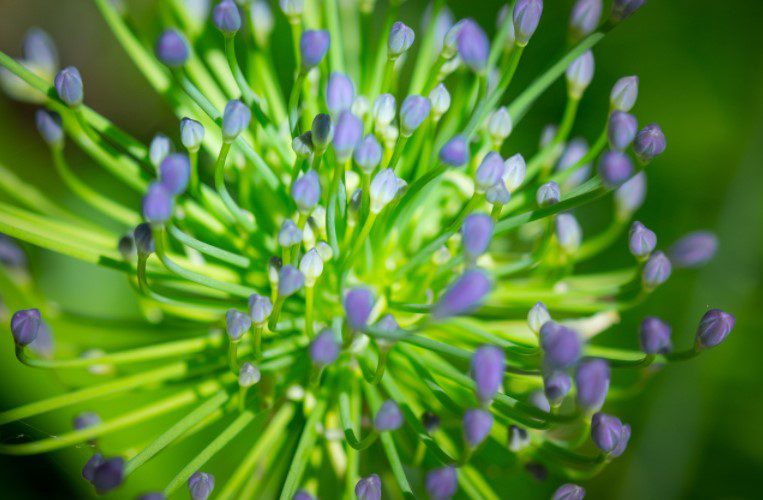Agapanthus
Agapanthus (African Lily) is a plant that will grow almost anywhere and thrives on neglect. From the wilderness of floral fashion, the humble agapanthus suddenly is the height of horticultural chic.
Their hardy ubiquity, especially at the seaside, has made them an almost iconic state bloom. They can tough it out almost anywhere. They thrive on neglect.
Where all else has perished amid rocky ruins of failed rural homesteads, agapanthus will continue to raise a blue bloom to remind of happier days.
There are many options, from a large container with 100 cm tall specimens to a smaller dwarf variety that mimics the classic look on a smaller scale.
You can add the classic Agapanthus Headbourne mid-blue to your mix, or you can crank up the intensity by using the deep cobalt from A.’ Northern Star,’ go for the slightly ombre effect with A.’ Liam’s Lilac’ or the haunting pale grey-blue effect of A.’ Windsor Grey.
This sun-loving summer beauty should be planted in any form that you prefer.
Agapanthus is native to southern Africa, where they grow in free-draining, rocky environments.
That makes it problematic for the roots to reach the water they need and forces them to plant well in constrained areas. This is important to remember when you plant Agapanthus into a pot.

To retain moisture, add lots of organic matter or John Innes No2 compost to your container. You can also slightly overfill the container to make sure they feel “hugged” inside their pot.
A lot of space for the roots can cause disappointing results for Agapanthus, despite this being a recommendation for plants to be grown in pots.
To ensure the best flowering displays, you’ll need to feed your Agapanthus during the growing season.
You can either treat them as clematis by giving them a regular tomato feed once every two weeks or treat them as roses and give them rose fertilizer twice a year in spring and summer.
You should immediately remove all spent seedheads after flowering to allow your plants to channel their energy towards regeneration and bulking up rather than future progeny.
Although it is unlikely that autumn drought will kill your plants, poor flowering will likely occur the following year.
No matter if they are evergreen, semi-evergreen, or deciduous, most agapanthus plants are not hardy.
Therefore, be prepared to protect them from frost damage by covering your pots with bubble wrap or using straw as a top dressing.
His deciduous plant is long-flowering and deciduous. The 100cm stems are a bit floppy, but this exceptional variety blooms well and will bloom throughout July and August.
Rhizome Roots
Agapanthus spreads through fleshy rhizomes, which also serve as storage roots. This allows the plant to retain nutrients in its roots and can be easily divided to make more plants.
Mix and match colors
Agapanthus leaves are quite subtle and vary depending on which species they are. Many varieties have small, grass-like leaves. Some have more slender, strap-like leaves ( similar to daylilies).
There are many varieties of agapanthus that have variegated leaves. These greens have a cream-colored or white stripe along the edges. This contrasts with the plant’s blue flowers.
The agapanthus blooms appear in clusters at each end of their flowering stems. The bracts protect the blue flowers from any damage as they rise from the leaves.
The bracts begin to pull back as they mature and reveal tiny blue buds. They then open in succession, working their way up from the bottom.
Blue is the most popular color for agapanthus flowers. However, they can be found in many shades, with a few streaks of darker blue down the petals.
Agapanthus is also available in white. A few varieties even have both blue and white flowers.
Agapanthus Care: Must-Knows
Many agapanthus species can be found in tropical climates. Non-evergreen varieties require more warmth and protection during cool seasons. You can start their dormancy when fall arrives by withholding water.
You can move the more delicate evergreen varieties into a frost-free environment like a greenhouse or near a bright window in your home. Others can be left alone and watered sparingly until spring.
Agapanthus loves regular watering. They don’t like to dry for too long. To prevent future blooms from being affected by stress, it is essential to water consistently after each bloom cycle has ended.
The good idea is to fertilize agapanthus plants regularly, as they are prolific bloomers.
Tips for Dividing and Deadheading Plants
Regularly dividing potted agapanthus plants is a good way to take care of them. Agapanthus are happy to be placed in a pot.
They do like to be divided every few years for new growth and increased blooms.
It is not necessary to divide agapanthus plants that are grown in the ground. However, you should remove any faded blooms from the stem.
This will promote new growth and stop the plant from wasting energy by producing seeds.
























Comments are closed.